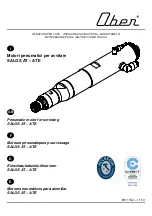
H9 ASD Installation and Operation Manual
21
I/O and Control
The H9 ASD can be controlled by several input types and combinations thereof, as well as operate within
a wide range of output frequency and voltage levels. This section discusses the ASD control methods and
supported I/O functions.
The
Terminal Board
supports discrete and analog I/O functions and is shown in
Figure 9 on pg. 24
.
Table 2
lists the names, functions, and settings (default settings of programmable terminals) of the input
and output terminals of the
Terminal Board
.
Note:
To use the input lines of the
Terminal Board
to provide
Run
commands the
Command
Mode
setting must be set to
Terminal Block
.
Typical Connection Diagram on pg. 26
shows the typical connection diagram for the H9 ASD system.
Table 2. Terminal Board Terminal Names and Functions.
Terminal
Name
Input/Output
Function
(Default Setting If Programmable)
(See
Terminal Descriptions on pg. 22
)
Circuit Config.
ST
Discrete Input
Connect to CC
to activate
(Sink mode).
Standby
— Multifunctional programmable discrete input. Activation required
for normal ASD operation.
Figure 10 on pg. 25.
RES
Reset
— Multifunctional programmable discrete input. Resets ASD.
F
Forward
— Multifunctional programmable discrete input.
R
Reverse
— Multifunctional programmable discrete input.
S1
Preset Speed 1
— Multifunctional programmable discrete input.
S2
Preset Speed 2
— Multifunctional programmable discrete input.
S3
Preset Speed 3
— Multifunctional programmable discrete input.
S4
Preset Speed 4
— Multifunctional programmable discrete input.
O1A/B
(
OUT1
)
Switched
Output
Low Speed
— Multifunctional programmable discrete output.
Figure 16 on pg. 25.
O2A/B
(
OUT2
)
Reach Frequency
— Multifunctional programmable discrete output.
FLA
Fault relay (N.O.).
Figure 19 on pg. 25.
FLB
Fault relay (N.C.).
FLC
Fault relay (common).
RR
Analog Input
Frequency Mode 1
—
Multifunction programmable analog input. (0.0 to 10
VDC input — 0 Hz to Maximum Frequency).
Figure 11 on pg. 25.
RX
Multifunctional programmable analog input (-10 to +10 VDC input).
Figure 12 on pg. 25.
V/I
(Select V or I
via
SW301
)
Unassigned
—
V
— Multifunctional programmable isolated analog voltage
input (0 to 10 VDC input)
Figure 13 on pg. 25.
Frequency Mode 2
(default
SW301
setting)
—
I
— Multifunctional
programmable isolated analog current input (4 [0] to 20 mADC input — 0 Hz
to Maximum Frequency).
AM
Analog Output
Output Current
—
Current output that is proportional to the output current of
the ASD or to the magnitude of the function assigned to this terminal (see
Table 8 on pg. 239
for assignment listing).
Figure 18 on pg. 25
FM
Output Frequency
—
Current or Voltage output that is proportional to the
output frequency of the ASD or to the magnitude of the function assigned to
this terminal (see
Table 8 on pg. 239
). Select
Current
or
Voltage
at
F681
.
SU+
DC Input
Externally-supplied 24 VDC backup control power (1.1 A min.).
P24
DC Output
24 VDC output (200 mA max.).
Figure 14 on pg. 25.
PP
10.0 VDC/10 mA voltage source for an external potentiometer.
Figure 15 on pg. 25.
FP
Pulsed Output
Frequency Pulse
— Multifunctional programmable output pulse train of a
frequency based on the output frequency of the ASD (see
Table 6 on pg. 237
).
Figure 17 on pg. 25.
IICC
—
Return for the
V/I
input terminal. (see
IICC
on
pg. 105
).
DO NOT
connect to
Earth Gnd
or to
each other.
CCA
—
Return for the
RR
,
RX
,
P24
, and the
PP
terminals.
CC
—
Return for the
AM
,
FM
,
SU+
, and the discrete input terminals.
Phone: 800.894.0412 - Fax: 888.723.4773 - Web: www.ctiautomation.net - Email: [email protected]
















































